Practice Free AZ-305 Exam Online Questions
HOTSPOT
You plan to migrate App1 to Azure.
You need to recommend a high-availability solution for App1. The solution must meet the resiliency requirements.
What should you include in the recommendation? To answer, select the appropriate options in the answer area. NOTE: Each correct selection is worth one point.


Explanation:
Box 1: 3
Scenario: App1 must meet the following requirements:
✑ Be hosted in an Azure region that supports availability zones.
✑ Maintain availability if two availability zones in the local Azure region fail.
A host group is a resource that represents a collection of dedicated hosts. You create a host group in a region and an availability zone, and add hosts to it.
Use Availability Zones for fault isolation
Availability zones are unique physical locations within an Azure region. Each zone is made up of one or more datacenters equipped with independent power, cooling, and networking. A host group is created in a single availability zone. Once created, all hosts will be placed within that zone. To achieve high availability across zones, you need to create multiple host groups (one per zone) and spread your hosts accordingly.
Box 2: 1
Scenario: App1 must meet the following requirements:
✑ Be hosted on Azure virtual machines that support automatic scaling.
An Azure virtual machine scale set can automatically increase or decrease the number of VM instances that run your application. This automated and elastic behavior reduces the management overhead to monitor and optimize the performance of your application.
Reference: https://docs.microsoft.com/en-us/azure/virtual-machines/dedicated-hosts
https://docs.microsoft.com/en-us/azure/virtual-machine-scale-sets/virtual-machine-scale-sets-autoscale-overview
HOTSPOT
You have an Azure subscription.
You create a storage account that will store documents.
You need to configure the storage account to meet the following requirements:
• Ensure that retention policies are standardized across the subscription.
• Ensure that data can be purged if the data is copied to an unauthorized location.
Which two settings should you enable? To answer, select the appropriate settings in the answer area. NOTE: Each correct selection is worth one point.

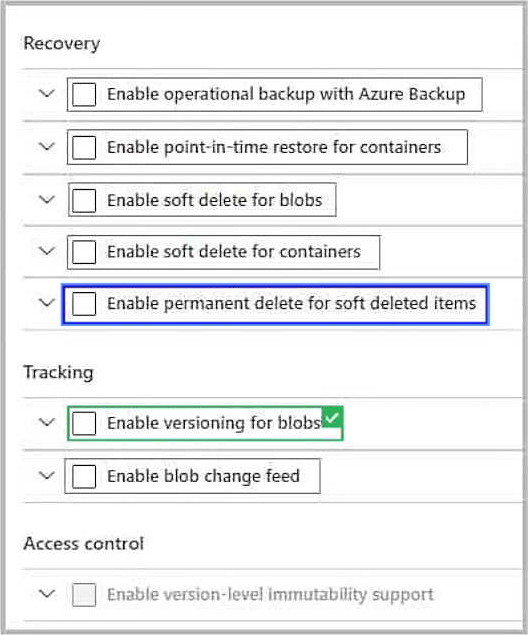
HOTSPOT
You plan to deploy an Azure web app named Appl that will use Azure Active Directory (Azure AD) authentication.
App1 will be accessed from the internet by the users at your company. All the users have computers that run Windows 10 and are joined to Azure AD.
You need to recommend a solution to ensure that the users can connect to App1 without being prompted for authentication and can access App1 only from company-owned computers.
What should you recommend for each requirement? To answer, select the appropriate options in the answer area. NOTE: Each correct selection is worth one point.
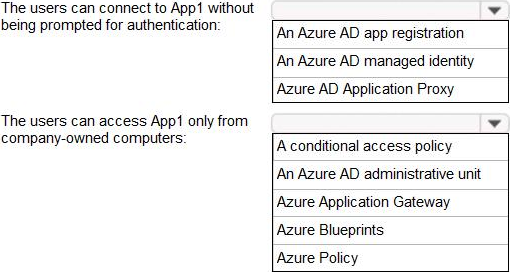
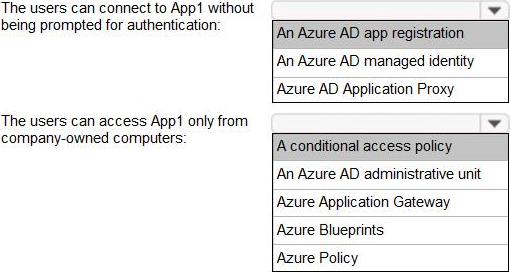
Explanation:
Box 1: An Azure AD app registration
Azure active directory (AD) provides cloud based directory and identity management services. You can use azure AD to manage users of your application and authenticate access to your applications using azure active directory.
You register your application with Azure active directory tenant.
Box 2: A conditional access policy
Conditional Access policies at their simplest are if-then statements, if a user wants to access a resource, then they must complete an action.
By using Conditional Access policies, you can apply the right access controls when needed to keep your organization secure and stay out of your user’s way when not needed.
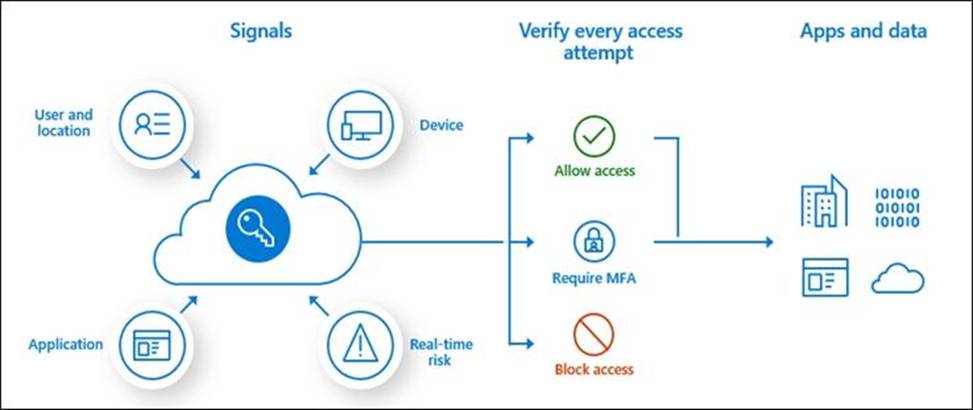
Reference:
https://codingcanvas.com/using-azure-active-directory-authentication-in-your-web-application/
https://docs.microsoft.com/en-us/azure/active-directory/conditional-access/overview
https://docs.microsoft.com/en-us/powerapps/developer/data-platform/walkthrough-register-app-azure-active-directory#:~:text=Create%20an%20application%20registration%201%20Create%20an%20application, the%20options%20and%20click%20on%20Add%20permissions.%20
"After consenting to use their Dataverse account with the ISV’s application, end users can connect to Dataverse environment from external application. The consent form is not displayed again to other users after the first user who has already consented to use the ISV’s app. Apps registered in Azure Active Directory are multi-tenant, which implies that other Dataverse users from other tenant can connect to their environment using the ISV’s app."
You plan provision a High Performance Computing (HPC) cluster in Azure that will use a third-party scheduler.
You need to recommend a solution to provision and manage the HPC cluster node.
What should you include in the recommendation?
- A . Azure Lighthouse
- B . Azure CycleCloud
- C . Azure Purview
- D . Azure Automation
B
Explanation:
You can dynamically provision Azure HPC clusters with Azure CycleCloud.
Azure CycleCloud is the simplest way to manage HPC workloads.
Note: Azure CycleCloud is an enterprise-friendly tool for orchestrating and managing High Performance Computing (HPC) environments on Azure. With CycleCloud, users can provision infrastructure for HPC systems, deploy familiar HPC schedulers, and automatically scale the infrastructure to run jobs efficiently at any scale. Through CycleCloud, users can create different types of file systems and mount them to the compute cluster nodes to support HPC workloads.
Reference: https://docs.microsoft.com/en-us/azure/cyclecloud/overview
You plan to migrate on-premises MySQL databases to Azure Database for MySQL Flexible Server.
You need to recommend a solution for the Azure Database for MySQL Flexible Server configuration.
The solution must meet the following requirements:
• The databases must be accessible if a datacenter fails.
• Costs must be minimized.
Which compute tier should you recommend?
- A . Burstable
- B . General Purpose
- C . Memory Optimized
HOTSPOT
You plan to use Azure SQL as a database platform.
You need to recommend an Azure SQL product and service tier that meets the following requirements:
• Automatically scales compute resources based on the workload demand
• Provides per second billing
What should you recommend? To answer, select the appropriate options in the answer area. NOTE: Each correct selection is worth one point.
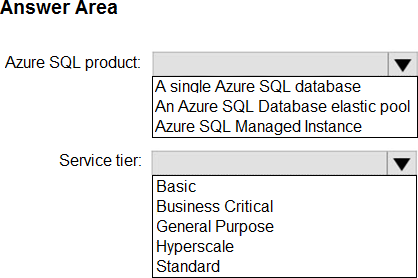
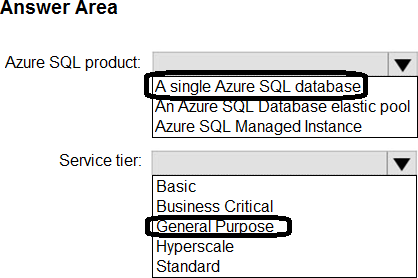
Explanation:
"Serverless is a compute tier for single databases in Azure SQL Database that automatically scales compute based on workload demand and bills for the amount of compute used per second. The serverless compute tier is available in the General Purpose service tier and currently in preview in the Hyperscale service tier." https://learn.microsoft.com/en-us/azure/azure-sql/database/serverless-tier-overview
Your company develops Azure applications.
You need to recommend a solution for the deployment of Azure subscriptions.
The solution must meet the following requirements:
What should you include in the recommendation?
- A . Provision resource groups.
- B . Support deployments across all Azure regions.
- C . Create custom role-based access control (RBAC) roles.
- D . Provide consistent virtual machine and virtual network configurations.
D
Explanation:
✑ Resource groups: You can scope your deployment to a resource group. You use an Azure Resource Manager template (ARM template) for the deployment.
✑ Regions: If you have a template spec in one region and want to move it to new region, you can export the template spec and redeploy it.
✑ RBAC: Azure role-based access control (Azure RBAC) is the authorization system you use to manage access to Azure resources. To grant access, you assign roles to users, groups, service principals, or managed identities at a particular scope. In addition to using Azure PowerShell or the Azure CLI, you can assign roles using Azure Resource Manager templates. Templates can be helpful if you need to deploy resources consistently and repeatedly
✑ You can setup Virtual machines and virtual network configurations in an Azure Resource Manager template.
Reference:
https://docs.microsoft.com/en-us/azure/governance/blueprints/overview
https://docs.microsoft.com/en-us/azure/azure-resource-manager/management/microsoft-resources-move-regions
https://docs.microsoft.com/en-us/azure/role-based-access-control/role-assignments-template
https://docs.microsoft.com/en-us/azure/virtual-machines/windows/template-description
HOTSPOT
You are evaluating whether to use Azure Traffic Manager and Azure Application Gateway to meet the connection requirements for App1.
What is the minimum numbers of instances required for each service? To answer, select the appropriate options in the answer area. NOTE: Each correct selection is worth one point.

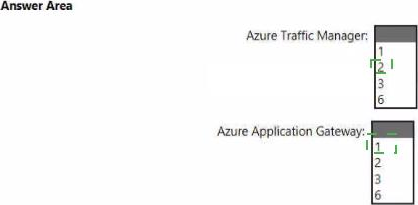
HOTSPOT
You are designing a cost-optimized solution that uses Azure Batch to run two types of jobs on Linux nodes. The first job type will consist of short-running tasks for a development environment. The second job type will consist of long-running Message Passing Interface (MPI) applications for a production environment that requires timely job completion.
You need to recommend the pool type and node type for each job type. The solution must minimize compute charges and leverage Azure Hybrid Benefit whenever possible.
What should you recommend? To answer, select the appropriate options in the answer area. NOTE: Each correct selection is worth one point.
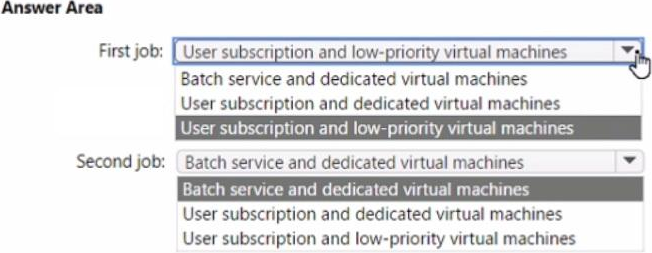
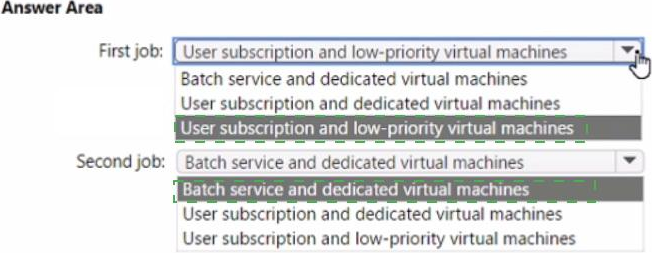
DRAG DROP
You have two app registrations named App1 and App2 in Azure AD. App1 supports role-based access control (RBAC) and includes a role named Writer.
You need to ensure that when App2 authenticates to access App1, the tokens issued by Azure AD include the Writer role claim.
Which blade should you use to modify each app registration? To answer, drag the appropriate blades to the correct app registrations. Each blade may be used once, more than once, or not at all. You may need to drag the split bar between panes or scroll to view content. NOTE: Each correct selection is worth one point.


